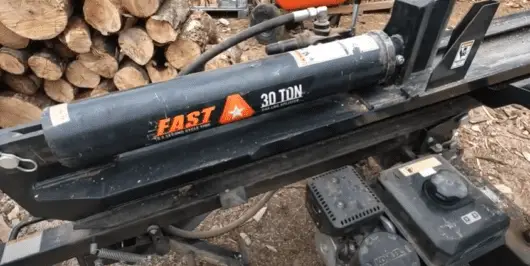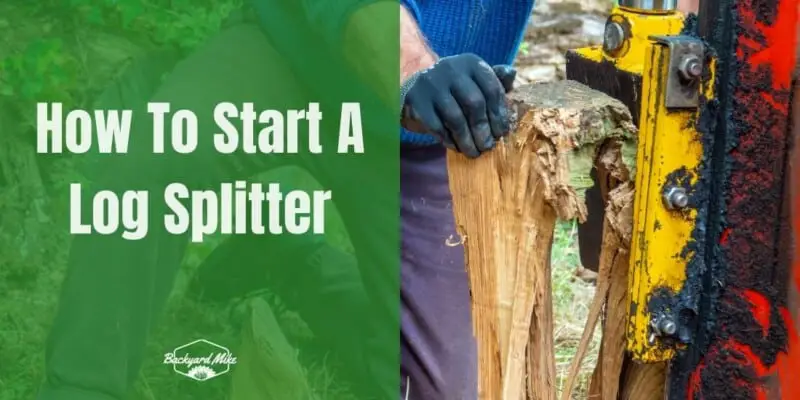While it may sound simple or mundane, there is the right way of starting a log splitter. That is one way to ensure the equipment serves you well and for long without breaking down.
This post covers everything you should know about how to start a log splitter and what to do when the log splitter doesn’t start.
How To Start A Log Splitter The Right Way
There are two main types of log splitters, hydraulic and kinetic log splitters. Both types are either gas or electric powered. This means gas-powered models have an engine, while electric-powered models have a motor.
Before starting a log splitter, there are some things you should take into consideration.
- Ensure you have gone through the instructions that came with the log splitter. I also suggest searching on YouTube for videos for people operating the model you own. That will make it super easy.
- If you have an electric-powered model, ensure the wiring is done correctly and check the voltage requirement.
- Make sure you have the best log splitter depending on your log load. The best size for you will depend on the type of logs, their sizes, and their diameter. For instance, if your logs are averaging 12 inches in diameter, the ideal splitter is any model ranging between 12 and 20 tons.
- Make sure that you are familiar with the functions of all control buttons and understand how to operate them. At least know which button shuts the machine down if there is an emergency.
- Only a single person should operate a log splitter. Accidents tend to occur more often when more than one individual runs the machine.
- In short, make sure the log splitter is in the best condition.

How To Start A Log Splitter – Step-by-Step
Step one: Safety first
Before anything else, safety first.
ALSO READ: How to use a wood splitter
When operating a log splitter, wear long protective pants and sturdy steel-capped work boots with heavy-duty gloves, glasses, and ear protection. Confirm the location of the emergency stop button and also take note of any pinch points as indicated by safety stickers placed on the log splitter. Most log splitters are designed for one-person operation, and any helpers should stay clear of the machine when it is operating.
Step two: Position the splitter
Instead of going back and forth for wood, the best strategy would be to set up the log splitter where the wood is located. Most log splitters have wheels to increase mobility and can also be towed on a truck or tractor if the logs are far out. However, when towing a log splitter, ensure you don’t exceed a maximum speed of 45 mph because the machines were not designed for higher speeds.
Step three: Start your log splitter
First, understand generally how a log splitter works. Hydraulic log splitters use a hydraulic system to push the wedge or log to the wedge, while kinetic log splitters use kinetic energy to push the log or wedge.
To start a gas-powered log splitter, you need to first turn on the fuel tap and the engine switch, then proceed to engage the choke, if it is a cold start. Now pull the starter cord out until a slight resistance is felt, then let the starter cord recoil and give a few sharp pulls until the engine fires or starts. As soon as the engine fires up, release the choke. For an electric-powered model, it’s straightforward. Just plug into the power socket and turn the power switch to “on”.
Step four: Splitting wood
Before you start placing wood, let the log splitter run for a few minutes at full throttle after it has been fired up to warm up the engine adequately. Position the log to be split with the grain. Ensure the log is balanced and sitting flat on a debris-free table without the danger of tipping or rolling over. Turn on the valve or manual lever to release the hydraulic cylinder that pushes the log onto the splitting wedge.
Step five: Remove the split log
Once the log is split, returns the valve slowly to retract the cylinder. You can safely remove the split logs from the flatbed and repeat the process if you have any logs left.
Log Splitter Will Not Start – Causes and Fixes
The majority of log splitters use hydraulic to power the force for cutting wood. To that end, most problems as to why your log splitter will not start can be attributed to the component, especially in regard to its power source and hydraulic pressure. There are other reasons why your log splitter won’t start; it could be anything from a dirty carburetor, failed spark plug, lousy gasoline, or broken recoil starter.
Bad gasoline usually affects the carburetor by clogging it. Try to clean the carburetor and replace the gas in the tank; if the splitter still doesn’t work, you need to replace the carburetor. Conduct a complete tune-up of the log splitter, regularly changing air filters, oil, and spark plugs because a dirty spark will not ignite the fuel to fire up the engine. If you pull the starter rope and the recoil starter does not spin the engine, you likely need to change the recoil starter.
For an electric log splitter, it will not start if there is no current or if the capacitor or switch is defective. If the engine is running, but the splitter won’t work, check the hydraulic oil levels or the control levers. Another cause will be if there is air trapped in the hydraulic fluid.
Conclusion
Starting and operating a log splitter is not that complicated. Remember, before purchasing any log splitter, ensure you take into consideration the kind of environment and logs it would be working on. Manufacturers also include a highly detailed user instruction guide that is beneficial to first-time owners. Ensure you go through the document to become familiar with your new log splitter. It is especially important to locate the emergency stop button in case the need arises, and children should not be allowed to handle or near a log splitter.


